Basically everyone has heard of the submarine that imploded 2 years back. Maybe you saw pictures of the debris or heard they used a wireless controller for the steering, but I assume most haven't looked much into it. I, however, did because I had to make a presentation for my First-Year Design class, and it turns out the case is even more baffling than it initially seemed.
OceanGate's goal with building this submarine, named Titan, was to open up manned deep-sea exploration. There are only a handful of manned deep-sea submersibles that can reach the average depth of the ocean1, and almost all are government owned. Making more of these submarines to expand deep-sea exploration and tourism is reasonable, despite possible societal and environmental implications. However, private business interests were at odds with ensuring the sub was as safe as possible. Entrepreneurship was put first.
The controller was the least of the submarine's issues. Stockton Rush, CEO of Oceangate, wanted the sub to hold 5 passengers. Others only hold 1-3, so this means he had to make the hull larger and cylindrical rather than the more pressure-resistant spherical shape of other submarine hulls. However, he also wanted the sub to be as light as possible to minimize transportation costs and make deployment easier. 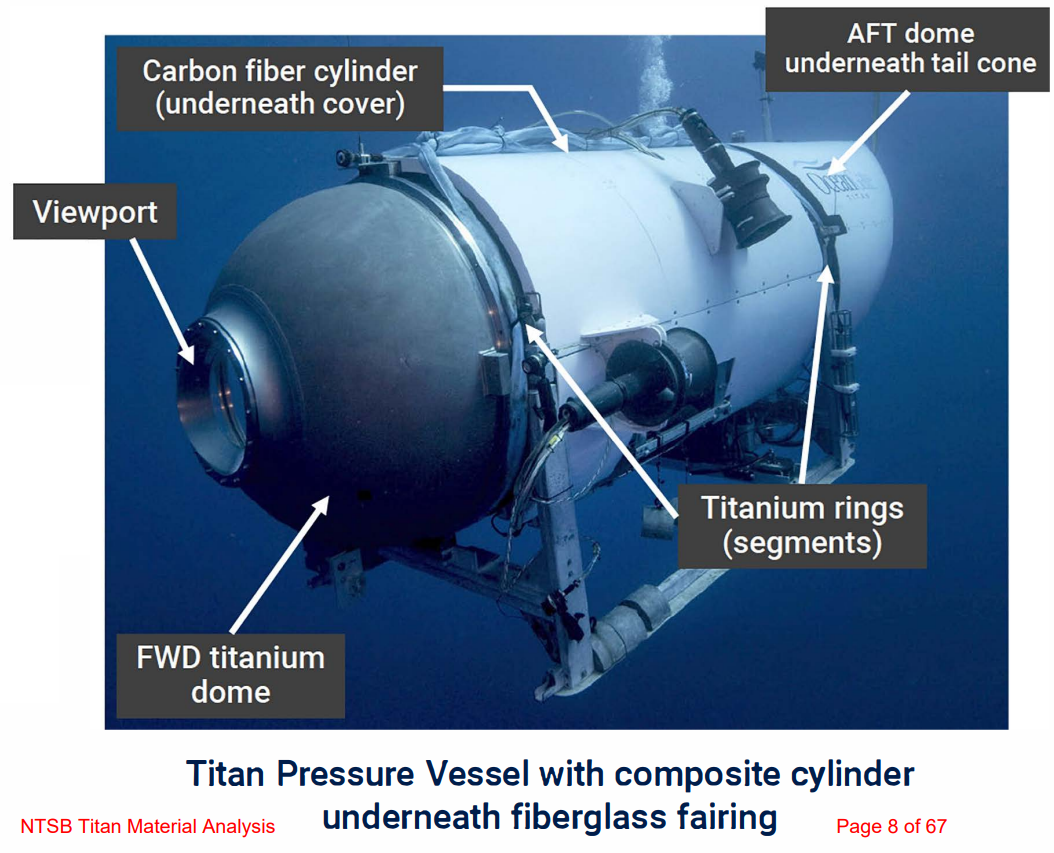 OceanGate's novel solution to this problem was to make the hull out of carbon-fiber rather than titanium or steel (Typical materials used for submarine hulls) because carbon-fiber has a much higher strength-to-weight ratio. The cylindrical hull was manufactured by machine-layering 5 1-inch-thick layers of carbon fiber with a resin matrix and an adhesive to bind them together. Some engineers say a problem with this design is that carbon-fiber, being rope-like in nature, is stronger under tension—When the pressure is greater inside the hull—rather than compression—When the pressure is greater outside the hull—, which is why carbon-fiber is used for aircrafts rather than submarines. Carbon-fiber is also known to weaken under repeated stress faster than titanium or steel, which would be an issue for a sub repeatedly undergoing a lot of pressure. However, if OceanGate consistently did non-destructive testing on the hull, they'd be able to detect any defects in the hull like pores or delamination2. In fact, the other concerns could also be dispelled if OceanGate had done enough testing to prove the safety of the vessel.
OceanGate's novel solution to this problem was to make the hull out of carbon-fiber rather than titanium or steel (Typical materials used for submarine hulls) because carbon-fiber has a much higher strength-to-weight ratio. The cylindrical hull was manufactured by machine-layering 5 1-inch-thick layers of carbon fiber with a resin matrix and an adhesive to bind them together. Some engineers say a problem with this design is that carbon-fiber, being rope-like in nature, is stronger under tension—When the pressure is greater inside the hull—rather than compression—When the pressure is greater outside the hull—, which is why carbon-fiber is used for aircrafts rather than submarines. Carbon-fiber is also known to weaken under repeated stress faster than titanium or steel, which would be an issue for a sub repeatedly undergoing a lot of pressure. However, if OceanGate consistently did non-destructive testing on the hull, they'd be able to detect any defects in the hull like pores or delamination2. In fact, the other concerns could also be dispelled if OceanGate had done enough testing to prove the safety of the vessel.
Rush, who died in the implosion, had a lot of things to say about safety. He was anti-regulation, and in a 2022 CBS interview he said "You know, at some point, safety is just pure waste...I mean, if you just want to be safe, don't get out of bed, don't get in your car, don't do anything." This quote is true! 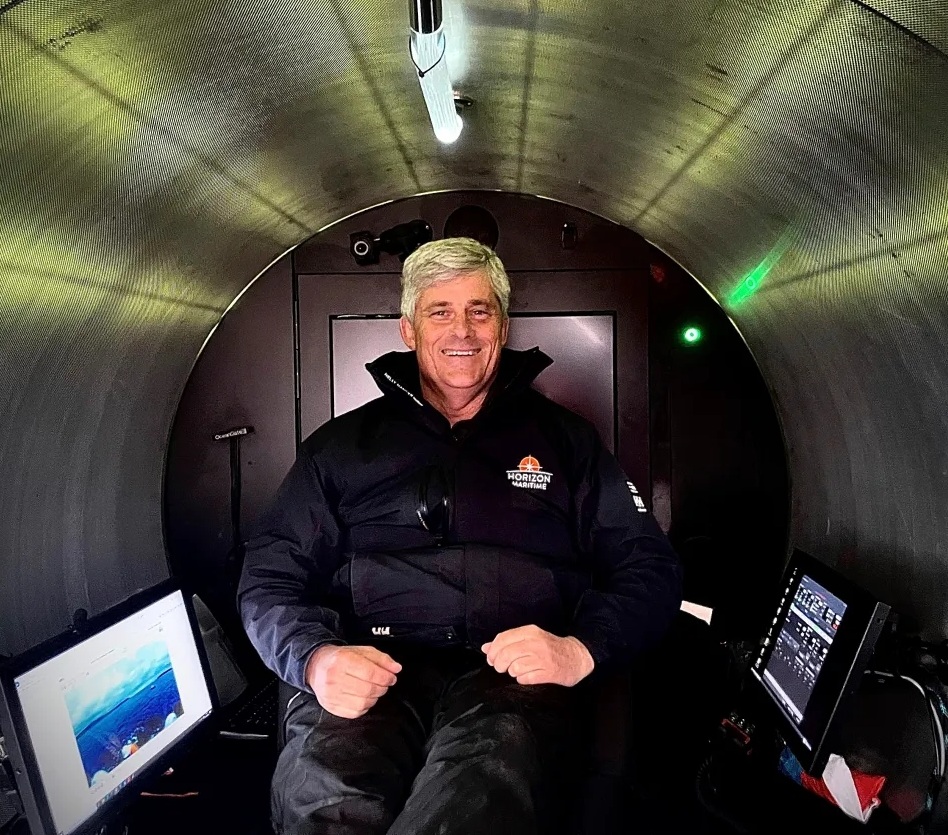 However, Stockton clearly misjudged the proper level of safety for a deep-sea sub by a mile (You could even say, about 4000 meters. hehe). Due to the experimental design of the Titan, it would have to undergo extensive testing to get classed by a third party agency like ABS or Lloyd's Register. Since OceanGate was a private entity, they were not required to class their sub, so Rush just forwent the process entirely, opting instead to implement an experimental "Real Time Monitoring" system with acoustic sensors and strain gauges on the hull to detect deformations. Engineers have pointed out that this system would not work for a brittle material like carbon fiber which buckles and fails catastrophically in an instant (like glass or wood) rather than deforming.
However, Stockton clearly misjudged the proper level of safety for a deep-sea sub by a mile (You could even say, about 4000 meters. hehe). Due to the experimental design of the Titan, it would have to undergo extensive testing to get classed by a third party agency like ABS or Lloyd's Register. Since OceanGate was a private entity, they were not required to class their sub, so Rush just forwent the process entirely, opting instead to implement an experimental "Real Time Monitoring" system with acoustic sensors and strain gauges on the hull to detect deformations. Engineers have pointed out that this system would not work for a brittle material like carbon fiber which buckles and fails catastrophically in an instant (like glass or wood) rather than deforming.
On top of the lack of certification, Rush did not do unmanned pressure testing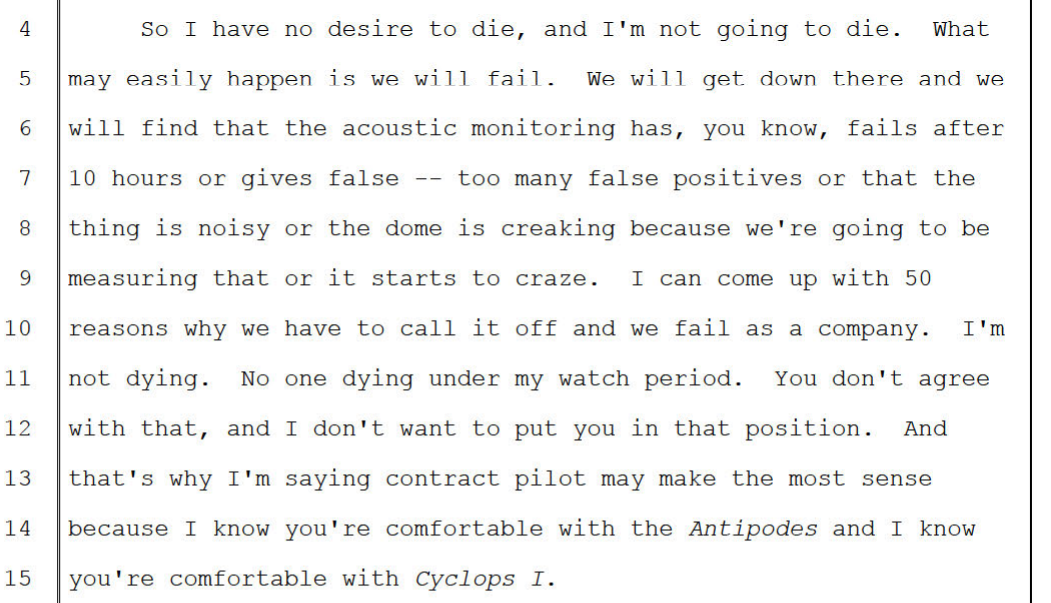 or non-destructive testing on the hull, ignoring the concerns of his engineers. (Two notable ones being David Lochridge and Tony Nissen - both fired) David Lochridge's recorded interview / firing by Rush definitely provides the best insight into Rush's complete disregard of safety and overconfidence in the sub. During their dialogue, Rush appears to have the insane approach that using the sub (WITH PEOPLE ON IT) is in itself "testing", among a bunch of other things that are funny to read in retrospect. He uses a lot shaky analogies to his prior experience with aerospace engineering. Rush was also able to further avoid regulations by registering the sub in the Bahamas, operating in international waters,
or non-destructive testing on the hull, ignoring the concerns of his engineers. (Two notable ones being David Lochridge and Tony Nissen - both fired) David Lochridge's recorded interview / firing by Rush definitely provides the best insight into Rush's complete disregard of safety and overconfidence in the sub. During their dialogue, Rush appears to have the insane approach that using the sub (WITH PEOPLE ON IT) is in itself "testing", among a bunch of other things that are funny to read in retrospect. He uses a lot shaky analogies to his prior experience with aerospace engineering. Rush was also able to further avoid regulations by registering the sub in the Bahamas, operating in international waters, 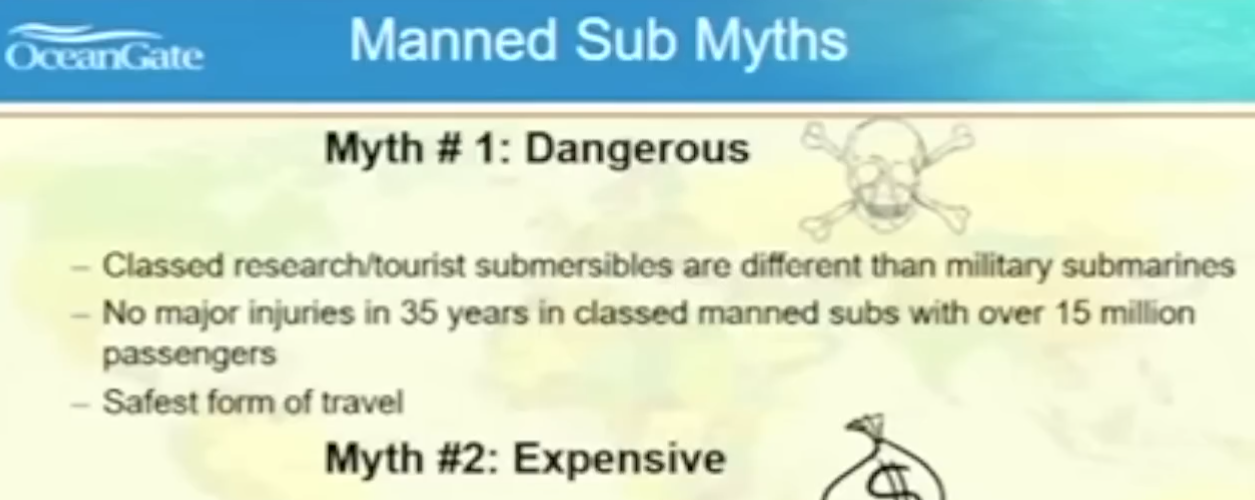 and referring to the paid tourists as "mission specialists", having them make a $250,000 "donation" to fund their mission in place of buying a ticket. Looking back at his explorer's club lecture from ~2017, Rush said submarines were the safest form of travel. It makes you wonder how it got that safe in the first place.
and referring to the paid tourists as "mission specialists", having them make a $250,000 "donation" to fund their mission in place of buying a ticket. Looking back at his explorer's club lecture from ~2017, Rush said submarines were the safest form of travel. It makes you wonder how it got that safe in the first place.
On a dive to the Titanic on June 18 2023, the Titan lost contact with its support ship after instantaneously imploding at ~3500m under the surface.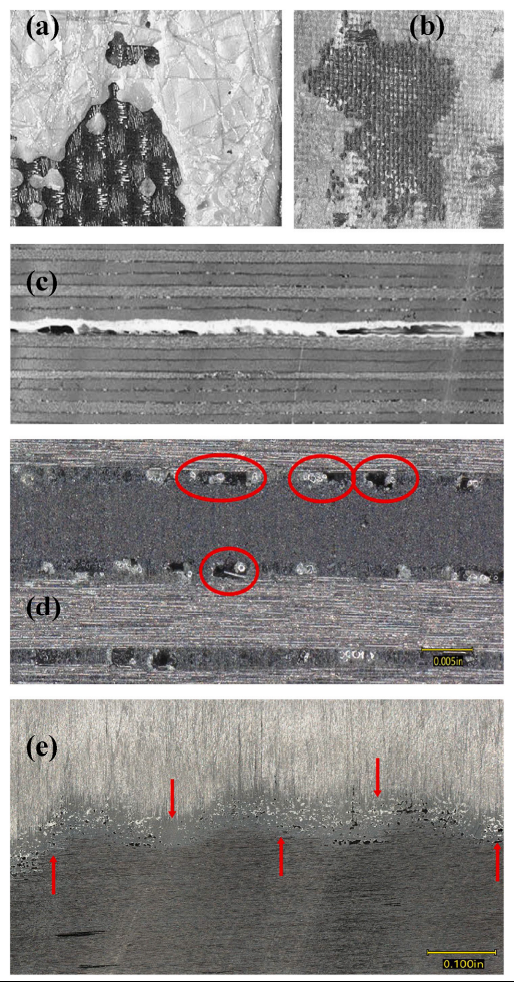 The specific catalyst of the implosion still isn't certain because all we're going off of is debris, but there are some clues to what may have happened. Pores and delaminations were found in the recovered layers of carbon-fiber, and there were areas where the adhesive had been ground into a powder, likely due to cyclical loading causing the bond between layers to decay. This study posits that a tiny breach in the outer layer of the hull let seawater in, causing the already weakened hull to rapidly buckle and implode, triggering a secondary explosion due to the pressure on the gases inside.
The specific catalyst of the implosion still isn't certain because all we're going off of is debris, but there are some clues to what may have happened. Pores and delaminations were found in the recovered layers of carbon-fiber, and there were areas where the adhesive had been ground into a powder, likely due to cyclical loading causing the bond between layers to decay. This study posits that a tiny breach in the outer layer of the hull let seawater in, causing the already weakened hull to rapidly buckle and implode, triggering a secondary explosion due to the pressure on the gases inside.
2 crazy things brought up in the hearings: The Real Time Monitoring system, despite its dubious functionality (And 3/8 of the acoustic sensors straight up just not working), actually did end up detecting something concerning. On dive 80 in 2022, there was a loud bang picked up by the acoustic sensors that coincided with a shift in the strain readings that persisted for subsequent dives. (More detailed explanation in this video) They just ignored it, though! Also, David Lochridge recounted a past dive to the Andrea Doria wreck in which Stockton was operating the submarine and had a Gamer Moment. He messed up the navigation so badly that they crashed directly onto the wreck, and it took 10 minutes for Lochridge, the experienced pilot, to convince him to hand over the controller. He did so by throwing it at Lochridge's head, breaking one of the buttons.
Being overly concerned with safety can stifle innovation, but the same can be said for overlooking safety. OceanGate had interesting, novel ideas in their construction of the Titan. Simplifying sub controls, making the experience more comfortable and engaging for passengers, and making subs lightweight are all good ideas. Unfortunately, the result of their corner-cutting is that all of these ideas have gained a bad name. It's possible that, having undergone all the proper testing, OceanGate could have modified their design to be safer or caught defects to prevent the tragedy from happening. It would've been the first deep-sea sub with a carbon-fiber hull, opening up new possibilities for submersible design. But that would've cost money which Rush didn't want to spend.
- Stuff you should look into if you're interested:
- Collection of info from the Coast Guard Marine Board of Investigation
- Video presentation of Coast Guard Materials Investigation from the hearings
- Stockton Rush Explorers Club Lecture
- David Lochridge's Testimony
- Study analyzing the failure of the Titan sub
- Stockton Rush Reddit AMA
- There a ton of videos and articles just look it up
Heres a song about a cooler submersible that I was listening to while writing this
A month ago I saw a flyer on the wall at my university advertising a neuroscience study and decided to get involved. This was my first time participating as a research subject, and it was pretty fun aside from a few things which I'll get into. The process to sign up was fairly simple. I just had to send an email, do a screening call, and go to an informed consent meeting before scheduling an appointment. The flyer mentioned the possibility of doing EEG testing (That cap with all the electrodes and wires) and experiencing things in VR, so I was excited for that.
 When I got there, it turns out I was gonna be doing EEG testing, but no VR, just reading Wikipedia articles. The researcher and his assistant chatted while, one by one, they squeezed conductive gel into the holes in my cap and then stuck on the electrodes. Once it was set up and they made sure all the electrodes were sending the proper signals, they had me sit at a desk in a small room with a computer and a platform to rest my chin on. The image you see is what the signals looked like. Each one is a different electrode! The fluctuations and noise are from me blinking and tensing up my facial muscles.
When I got there, it turns out I was gonna be doing EEG testing, but no VR, just reading Wikipedia articles. The researcher and his assistant chatted while, one by one, they squeezed conductive gel into the holes in my cap and then stuck on the electrodes. Once it was set up and they made sure all the electrodes were sending the proper signals, they had me sit at a desk in a small room with a computer and a platform to rest my chin on. The image you see is what the signals looked like. Each one is a different electrode! The fluctuations and noise are from me blinking and tensing up my facial muscles.
My task was to read 5 faux-Wikipedia articles and answer comprehension questions about them. The platform was there to keep my head stable because they were tracking my eye movement. Before each article, they'd calibrate the eye tracker by having me look at little cross hairs which popped up in different parts of the screen. I like reading Wikipedia articles in my spare time, but the way I was instructed to read these articles was quite stressful; I wasn't allowed to dart my vision back to previous words. Just looked it up and this is apparently called "regression" and it might be a bad habit, though it seems like it would be normal to do that when you're trying to comprehend/memorize information. Either way, it's pretty hard to force myself to read like that, and it got tiring. Also, my posture on the chin platform got uncomfortable, and the tight EEG cap starting hurting my head, but I just toughed it out.
I spent about 2 hours in that room, counting the little breaks I got between the articles. The 5 articles were about The Voynich Manuscript (Cool! I didn't know about this), Serena Williams (Tedious), Pluto (Learned some new tidbits), The Prisoners Dilemma (Tidbits), and The Early History of Film (Tidbits). (Wikipedia articles tend to have a bunch of kind of random tidbits in them). I remembered the answers to most of the comprehension questions. All in all, this study was a kind of fun experience and as a bonus I got paid ~$45 for my time. I still don't exactly know what they were looking for in this research. The researchers just gave a vague answer, something like: "How people's brains respond to certain sensory stimuli" which could probably describe a lot of neurological studies.
Lost track of time writing this and was late to Calc III. Whoops!

New website I just made. Working on pages and stuff. It's my birthday!!!

